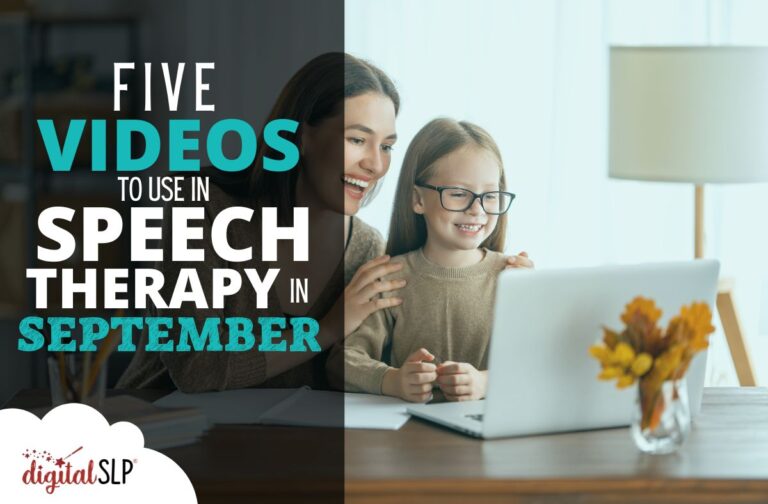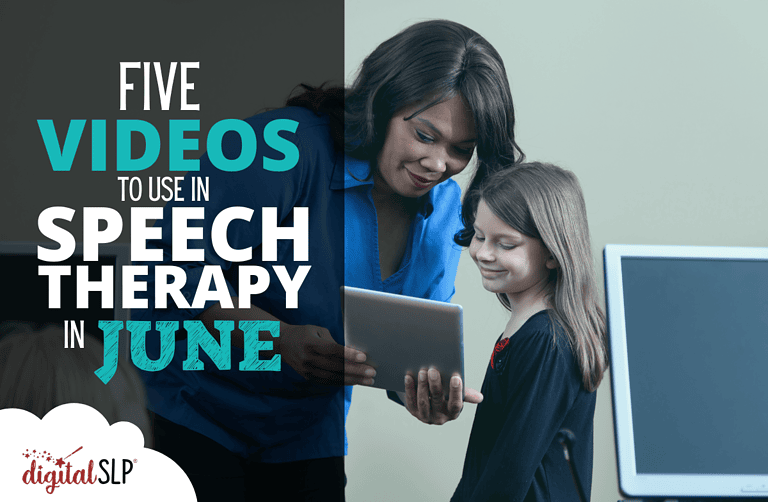It’s gloomy outside, but this month’s videos are full of life and color! There’s something here for just about every age group and goal area, so I hope these recommendations make your February speech therapy planning easier.
Just a quick reminder: I watched all these videos and found them to be worthwhile, but everyone’s needs are different, so please preview any video before sharing it with students.
Let’s jump in!
Length: 6 minutes
Ages: 2nd grade–6th grade
Socratica Kids is a versatile YouTube channel covering a range of topics, including science, math, literacy, and even ballet! This particular video is ideal to share near Groundhog Day on February 2nd.
Dig into the world of groundhogs with these ideas:
- Groundhog Day is all about weather prediction, so it’s an opportunity for students to practice predicting as well! They could also research Punxsutawney Phil and check his 2024 forecast.
- Tongue twister: Groundhogs are also known as woodchucks, and this video includes the classic tongue twister “How much wood would a woodchuck chuck if a woodchuck could chuck wood?” This could be a silly but effective way for students working on any of the sounds in the tongue twister to get some extra practice. Or, it could be a warm up for students working on fluency strategies.
- February is a big month for rodents, with Groundhog Day on the 2nd and Squirrel Appreciation Day on the 21st. Students could compare and contrast these two animals.
- Groundhogs are known by many different names: chuck, whistle pig, whistler, Canada marmot, ground pig, and more. Students could discuss which name is their favorite, and what they would choose as a new groundhog name if they had the opportunity.
- Groundhog teeth are a dentist’s nightmare—they never stop growing! These little creatures have to gnaw on wood to keep things under control. Students could respond to questions like “Would you rather chew on wood or go to the dentist?” and “Would you rather have an early spring or six more weeks of winter?”
Length: 6 minutes
Ages: Kindergarten–5th grade
Elementary school teacher Amber Freshour’s YouTube channel Fresh Reading is full of delightful read-alouds, including this sweet winter story (perfect for celebrating World Read Aloud Day on February 7th). Its setting is chilly, but its central message is full of warmth, reminding students that they can do big things, even when they’re small.
Here are some skills to target and activities to try with this video:
- Phonological awareness: There are many fun pairs of rhyming words for students to identify and discuss in this video.
- Articulation/phonology: This story is all about yaks, and the main character’s name is Gertie, so there are plenty of opportunities for students to work with /k/ and /g/!
- Verbs: Wiggly students will enjoy using this story as an opportunity to act out its many energetic verbs, including hop, skip, plop, leap, cling, shiver, and quiver.
- A pivotal plot twist begins at the 3:35 mark—you could pause the video and ask students to predict what will happen next.
- Gertie’s angst and adventures could inspire social-emotional learning discussions about diversity, self-acceptance, and courage.
Length: 4 minutes
Ages: Kindergarten–5th grade
The Lunar New Year begins on February 10th, and it’s the year of the dragon—a perfect time to talk about dragons during speech sessions. Technically, Komodo dragons are actually the world’s largest lizards, but they certainly look like dragons! This short video shares information about their appearance, habitat, diet, and more. It’s from the appealing Hey! Guess What channel, which features videos for kids by kids (and a zany sock puppet named Gus).
This video could support many different goal areas. Here are some options to explore:
- Phonological awareness/syllables: “Komodo” is a fun 3-syllable word, and it appears in this video many times, providing plenty of opportunities to clap and count the syllables.
- Tier II vocabulary: Useful science-focused words abound in this video! Examples include percent, weight, carnivore, prey, toxic, predator, and species.
- Describing: Students could brainstorm adjectives to talk about these unique animals.
- Wh-questions: The fact-filled format of this video lends itself well to straightforward wh-questions practice.
- Students are likely to be intrigued by these massive creatures! Please be cautious if you help them do additional research during speech sessions—many YouTube videos about Komodo dragons are heavy on “eating a live goat” content. (And even the video in this post might be a bit much for very sensitive little ones.)
Length: 4 minutes
Ages: 2nd grade–12th grade
About 11 years ago, Kid President took YouTube by storm with his joyful videos. Now, he’s a college student, not a kid—but his videos are still relevant, hopeful, and uplifting. In his guide to making a new friend (a great discussion starter for National Make a Friend Day on February 11th), he creates a list of friend-making tips for himself, and then puts them into practice with his sweet new pal Donna.
This heartfelt video has so much to offer, especially for social skills groups! Here are ideas for how to use it in your sessions:
- Personal narrative: Both of the young people in this video talk about experiences of feeling different—Donna as a Muslim, and Robby (Kid President) with his diagnosis of osteogenesis imperfecta. Students could talk about times when they felt different as well.
- Social-emotional learning: Throughout the video, Robby models friendship skills (smiling, asking follow-up questions, showing genuine interest, etc.) and he’s awkward, nervous, and hesitant. Students could discuss what they observe (and hopefully begin to embrace the idea that “awkward is awesome,” as Kid President would say).
- Social-emotional learning: Students could create their own lists of friend-making tips and questions to ask new friends.
- Discussion skills: Students could talk about whether they agree or disagree with the statements in the video (e.g., “awkward is awesome”) and why.
- Sequencing: Using the video as a reference guide, students could make (and discuss) a list of the steps in making a new friend.
Length: 4 minutes
Ages: 1st grade–5th grade
SciShow Kids is one of our favorite YouTube channels, with 500+ high-quality, standards-aligned videos about any science topic you could imagine. This one shows students the world of engineering and the different career paths within the field—it’s a useful companion for Introduce a Girl to Engineering Day on February 22nd.
Here are some additional tips for using this video in speech sessions:
- The host Jessi emphasizes that engineers care about both how and why things work—a great review opportunity for students who are still learning the difference between how and why.
- Social-emotional learning: Curiosity is critical for engineers! Students could brainstorm additional careers and the traits needed to excel in them.
- Problem-solving: Engineering is all about solving problems. Students could identify an everyday problem and try to design a solution.
- This video briefly describes the work of civil engineers, mechanical engineers, electrical engineers, software engineers, and aerospace engineers. Students could choose one type of engineer to research in greater depth, or discuss which type of engineer they would most like to be and why.
- As Jessi points out, 100 years ago we didn’t have aerospace engineers! Students could answer this question: what new kinds of engineers do you imagine we’ll have in the next 100 years?
I hope you and your students enjoy these videos and ideas!
If you love using videos in your speech sessions and want weekly recommendations and activity suggestions in your inbox, consider signing up for a Digital SLP membership! This is just one of the many bonuses you receive when you become a paid subscriber. Click here to learn more.













Recent Comments